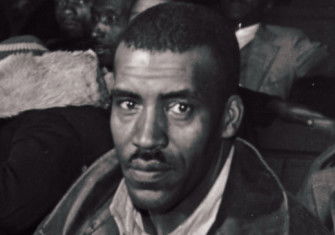Brutal Saviours of the Black Patch
In 1904, when tobacco farmers of Kentucky and Tennessee formed an association to unite against the American Tobacco Company, a vigilante splinter group decided to deliver its own brand of rough justice.
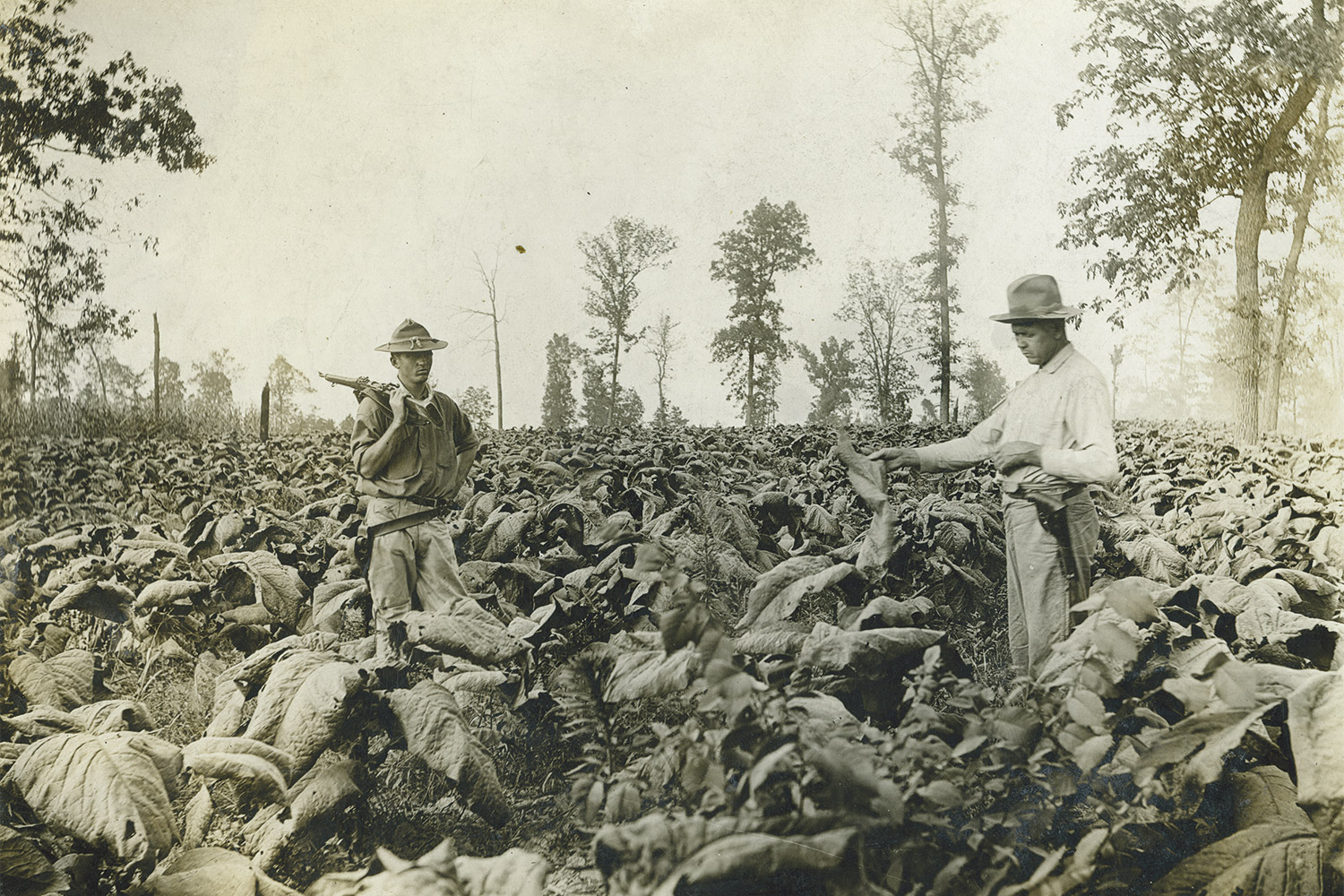
Former Night Rider Milton Oliver on his tobacco patch. He is guarded by state militia, having been shot in 1910 for revealing the identity of the leader of the Riders.
Deepest night in southern Kentucky, the humid air thick with the sprightly scent of tobacco plants. The men approach the darkened farmhouse silently, draped in black, hoods covering their faces, their horses’ hooves wrapped in burlap to muffle their step. They would have been unseen, even if anyone had been watching for them, until it was too late.
As they surround the property a dog barks and the night is split apart with successive bursts of gunfire. Flame belches from the muzzles of deer rifles and double-barrelled shotguns, windows explode and wood splinters. A gutter is severed and slides like the arm of a dying man down the front of the façade. The shooting ceases as the front door tremulously cracks open. A young woman appears, her nightgown bright with blood about the neck from a gunshot wound, and staggers weeping into the yard. A man, similarly garbed, follows close behind her, entreating the mob for mercy. Sobbing hysterically, a child reels out of the door and falls on his knees to the porch, his nightclothes stained with his mother’s blood. He watches wide-eyed as the masked men surround his parents.
They are shouting ferociously at the couple, cursing in words the boy has never encountered. Three of the invaders seize the man and sling him face-first against a tree trunk, one holding each of his arms outstretched in a cruciform position while the third advances with a horsewhip. The child howls in anguish while his father is beaten. The woman cries out and rushes to his aid but is punched by another masked man and falls to the ground, where she is kicked until she curls sobbing within herself.
The beating continues until the man slumps nerveless between his tenders, blood-soaked rags of cotton and torn skin gleaming in meagre starlight. Satisfied, the men drop him at the foot of the tree and file wordlessly out of the yard back towards their tethered mounts. Just before crossing the tobacco patch one of them turns back for a final warning: ‘Get out of the county and never come back or you will be killed.’ Across the fields, roosters welcome a new dawn. By nightfall the bullet-riddled farmhouse stands hushed and empty.
The attack on this tobacco farmer Robert Hollowell and his wife Mary Lou on 1 May 1907 was only one of the more savage of many similar events that occurred in an area of south-western Kentucky and north-western Tennessee in the first decade of the 20th century, a region known as the Black Patch for the luxurious dark-fired ‘plug’ (chewing) tobacco that was its main source of revenue. The Black Patch War, like much human conflict, was rooted in economics, specifically the monopolistic practices of the American Tobacco Company. Founded in 1890 by James Buchanan Duke, younger son of tobacco farmer Washington Duke, the North Carolina family corporation had established itself as an international consortium that could dictate its prices to farmers with little need for negotiation. When you control the means of a crop’s supply and distribution to the world market you control the lives of those producing it and ‘Buck’ Duke was well aware of this. He had recently abolished the competitive system of bidding for tobacco by simply buying out his rivals.
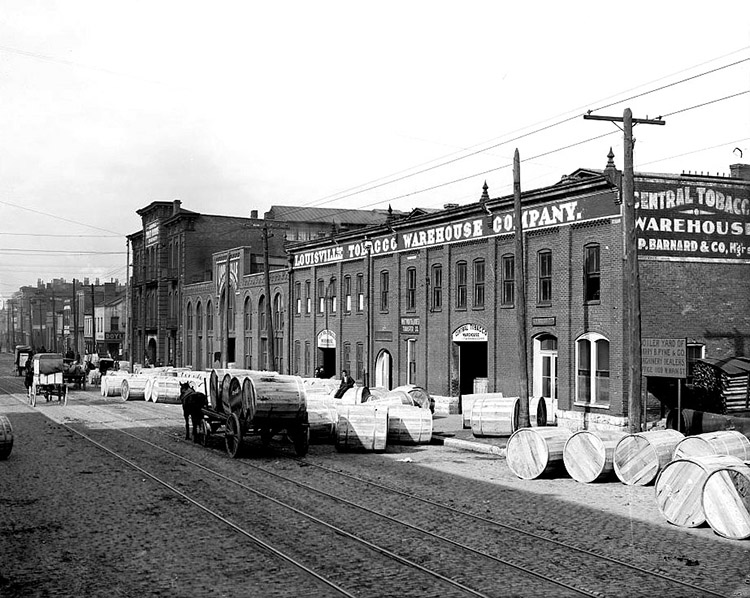
Duke possessed an ego outmatched only by his ambition. Seeking to expand his cartel, Duke found inspiration in the exclusivist tactics of John D. Rockefeller’s Standard Oil Trust – one of the first and largest of the world’s multinational corporations, whose absolute monopoly was dissolved by the US Supreme Court in 1911. After Duke had bought out or seduced most of the competing tobacco companies he instigated a campaign of underselling the remainder until they cried mercy and were subsumed into what was becoming known and generally despised as the Duke Trust. Buck then bought the rights to the new machines that created the latest international sensation, the cigarette, while not ignoring the markets for plug and pipe tobacco. The Trust soon controlled every aspect of tobacco use: buying, transporting and transforming the long, broad, veiny leaves into addictive products that enchanted the world. By the turn of the century the Duke Trust sold 82 per cent of the country’s tobacco products using 400 million lbs of leaf tobacco and Buck Duke, whose father had grown up on a one-mule tobacco farm, was one of the world’s richest men.
In 1900 a Black Patch tobacco farmer could expect to earn six to eight cents for a pound of cured leaf; four years later the price had dropped to two or three cents, due to the Duke Trust’s domination of the market. Many farmers went hungry and banks and businesses that relied on their farming clientele went under. Crime increased as desperation set in. The Black Patch smouldered with helpless rage.
Felix Ewing was a successful middle-aged Nashville businessman and planter with 3,000 acres in dark-leaf tobacco, but like his poorer Tennessee neighbours he seethed at the pains being inflicted by the Duke Trust. Noting the powerlessness of the Black Patch farmers in the face of consolidated buyers, he hit upon a potential solution to their predicament. Duke controlled tobacco prices by having become the sole market; therefore Ewing and his farming brethren would themselves unite and demand a fair price for their product. By boycotting the Duke Trust together in one of the first large-scale labour alliance propositions in US history, they could reclaim the freedom and self-reliance that they had been robbed of.
In the summer of 1904 notice went out across the Black Patch of a gathering in the settlement of Guthrie, Kentucky, to discuss the formation of an organised resistance to the Duke cabal. Five thousand planters, white and black, arrived on cue. Ewing had arranged for barbeque, bourbon and musical entertainment, while speech after speech detailed the unholy excesses of the Duke Trust. The Dark Fired Tobacco Planters’ Protection Association was thereby initiated, with Ewing installed as general manager.
The notion of collective resistance to the Trust spread like wildfire, enlisting farmers from throughout the Black Patch but also drawing into the fold professionals, politicians, shopkeepers and clergymen. Spurred on by stories in the local papers of the righteousness of American populism, around 70 per cent of the region’s farmers would eventually join the Association. A second Guthrie rally took place on 23 September 1905, with attendance three times that of the previous year. Another year of privation had aggrieved the Association’s poorer members and there were mutterings of taking the fight to the enemy in a more direct fashion. There continued to be farmers (contemptuously referred to as ‘hillbillies’) who refused to join the movement and who were selling their tobacco to the Duke Trust for a higher rate because of the Association’s boycott.
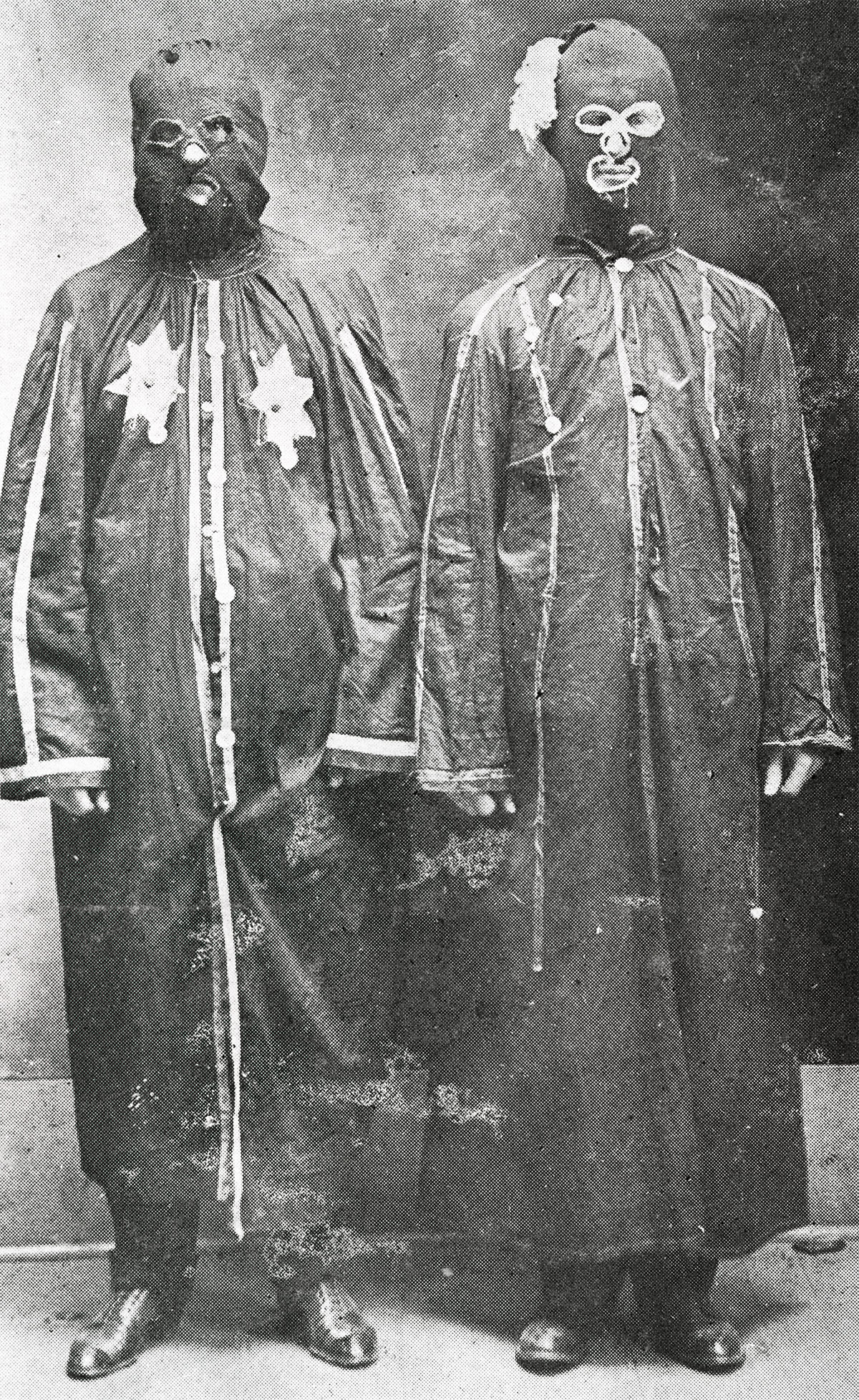
A few weeks later, 32 farmers gathered at dusk in a tiny schoolhouse set among the tobacco fields, near the Kentucky border in Robertson County, Tennessee. The men were there to listen to a declaration written by Felix Ewing and a Kentucky physician and planter named Dr David Amoss, which invoked ancient ideals of liberty and justice and tarred the Duke Trust and all who supported it as heretics to the grand Jeffersonian ideal of the yeoman’s sacred freedom and independence. The statement concluded with an ominous pledge to the hillbillies:
Be it further proclaimed to the world that any farmer or persons who aid the Trust in any way by selling to it their tobacco at a higher price is an accomplice of the Trust and is in good morals as guilty as the Trust.
The rallying cry was couched in terms similar to those of the American Revolution: join or die.
The conspiracy sprang into action with a leaflet targeting those farms recalcitrant to the ideas of the Association, a warning that underscored the divisions that had solidified in the past year across the Black Patch. Still the ‘hillbillies’, enjoying their new-found wealth, refused to toe the line. David Amoss decided that something more was needed to unite the planters against the Duke Trust and he was willing to devote himself to achieving this end.
As was common among the upper-middle classes in the South at the time, Amoss had been sent as a boy to a military school, where he learned the basics of drill, strategy and tactics, lessons that would be put to good use as the conspiratorial Night Riders emerged as an underground sect within the Association that would perform the ugly work of persuasion. Secret night-time meetings were held throughout the Black Patch, with the Night Riders’ underlying purpose delivered by Amoss in firmly Jacobin terminology:
To burn or otherwise destroy the property of growers and to whip them and others who refuse to co-operate with you in winning your fight against the Trust is more than they deserve. There is no reason why a few persons should continue to make the masses suffer when their cooperation would not only be to their benefit, but would increase the earnings and thus improve the conditions of all equally.
The Night Riders’ oath, sworn by lantern light on bended knees and with one hand on the Bible, was couched in scriptural references to the paramount importance of being one’s brother’s keeper (willingly or not) and to the equally supreme necessity of total secrecy. By the spring of 1906 around 2,000 men had taken the oath and, orders in hand, spread out into the countryside to do their work.
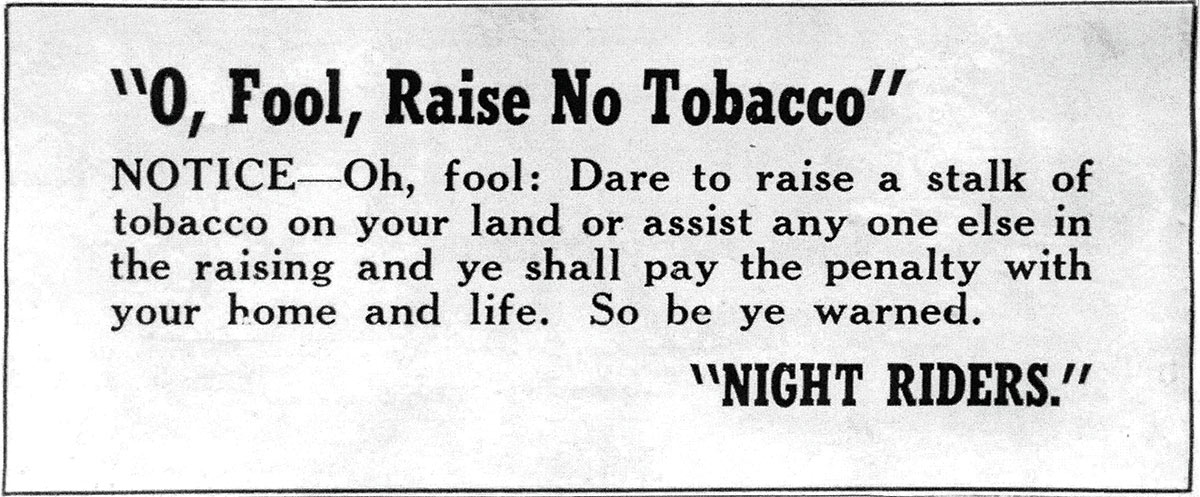
Tobacco farmers themselves, the Night Riders knew just how to inflict the maximum harm on their victims. They knew precisely the moment to strike the hillbillies’ seed beds, where the embryonic tobacco plants were covered with a porous canvas shroud to protect the delicate shoots, too late in the season for them to be replanted, either trampling the shoots or spraying the canvas with kerosene and igniting it, or, perhaps on the direction of the classically-minded David Amoss, sowing the beds with salt. On the last night of November 1906 the Night Riders upped the ante. Two policemen dozing through the late shift in the small Kentucky town of Princeton awakened in a most unpleasant manner to find themselves staring wide-eyed into the barrels of rifles held by six masked men. Outside, hooded accomplices, their boots wrapped in muffling gunny-sacks, jogged silently down the wood-planked sidewalks. Some axed the telephone and telegraph cables, others seized the firehouse and cut off its water supply. Meanwhile a band of 200 mounted Night Riders swept inaudibly into town on a cold black wind, heading calmly toward the J.G. Orr Tobacco Factory.
At the tobacco warehouse, owned by a prominent ‘hillbilly’ planter, the front door was smashed open and the cured tobacco heaped inside was soaked with kerosene as sticks of dynamite followed by flaming torches were hurled inside. Within moments explosions rent the building apart as the dynamite detonated. The centre of Princeton was a glaring, earsplitting holocaust of fire and explosions; the shocked townspeople, awoken from slumber by this awful visitation, must have thought the End had come.
Those residents courageous enough to brave a glance outside would have seen a thin man on horseback blowing three sharp blasts on a horn, summoning his riders to depart. For David Amoss this spectacle was a thundering blow against tyranny, accomplished with military precision. The Trust would surely get the message – the men of the Association would accept wage slavery no longer and those willing to work with Duke’s henchmen would pay the price. There would be no turning back.
Buck Duke thought of the Association, which was now seriously impeding the flow of tobacco to his warehouses, as composed of rednecks and ‘hoe-toters’ led on and manipulated by ‘outside agitators’, communists and anarchists out to subvert the American Way. Labour unrest was bad enough when confined to the Northern cities, with their teeming immigrant shanty towns, but to have it rear its head in the rural South, the very cultural soil from where the Duke fortune had been wrung, was sacrilege. And now there was another troublemaker that monopolies such as the Duke Trust had to contend with. The new president Theodore Roosevelt’s rabble-rousing ‘trust-busting’ campaigns had reawaken the moribund 1890 Sherman Antitrust Act, a dangerously progressive piece of legislation that would eventually prohibit anti-competitive business practices and hence flew in the face of everything Duke and his brethren stood for.
The Association would not have looked to a Yankee, much less a Republican like Roosevelt, for help. Given the success of the Princeton raid, Amoss must have felt he had things very much under control. The Dark-Fired Planters’ Protection Association and its Night Riders’ wing was beginning to make a positive difference in the lives of its members, slowly raising the price of tobacco as more and more pro-Trust warehouses went up in flames. As one member noted at the time, the Association:
has fed more hungry children, paid off more mortgages, put clothes on more poor children than any other organisation that ever existed. I will keep on working for the Association and if need be I will die in the ditches with the boys from the furrows.
On the night of 6 December 1907 hundreds of masked men from the surrounding countryside converged on Hopkinsville. Then a comparative metropolis of the Black Patch and the seat of Christian County, Kentucky, the town had a population of 8,000. In the winter of 1907 it housed two of the Duke Trust’s biggest warehouses in the state. As at Princeton, curious civilians were swiftly ushered back inside by barrages of buckshot. They waited quaveringly in the darkness until a vast orange glow from downtown signalled the demise of the immense Trust warehouses there. The newspaper office was thoroughly ransacked. Trust sellers were dragged from their homes and viciously beaten. Several men were shot trying to escape, though miraculously no one was killed. Their work completed, the column of masked men rode off into the night, boisterously singing their own version of the state anthem, ‘The Fires Burn Bright on My Old Kentucky Home’.
The Night Riders were now national news. Vituperative screeds of alarm arose from the mouthpieces of the Establishment at these savages from wildest Kentucky and their anarchic onslaught on international capitalism. The Riders’ tactics – their shadowy approach; their terrifying namelessness; their use of guns, fire and heavy explosives; the savage treatment of their enemies – had cast a pall of nightly fear across the entire Black Patch. One New York merchant who had been in Hopkinsville during the raid sent a telegram to his employer the next day: ‘Arrived Hopkinsville midnight – Stop – Checked into hotel at one – Stop – Night Riders filled room with bullets at two – Stop – I quit – Stop’.
The Association had reached the height of its success in 1907, with tobacco prices at more than eight cents per lb. The pro-Trust ‘hillbillies’, chivvied and terrorised into submission, had largely ceased to be a matter of concern. The battle won, there began to be talk in the confidential meetings of the Night Riders of setting aside the hood and the lash and reassuming a normal life of tilling the soil and curing the baled leaves. Then the Commonwealth elected as the new governor of Kentucky Augustus E. Willson, an urbane Republican attorney and firm friend of big business.
Political power had long resided in the wealthy, agrarian, Confederate-sympathising and largely Democratic flatlands. One of the few Republicans of the era to be elected governor, Willson was despised in the Black Patch for his corporatist leanings and for being from Louisville, then the state’s only metropolitan area and to this day the focus of mutual distrust and contempt by those living ‘out in the state’. Willson campaigned on a promise to disarm and disband the Night Riders with all available force, something his Democratic predecessor had silkily avoided. Upon his election Willson promptly sent a company of state militiamen to Hopkinsville to replace the compromised local forces and protect the city from further outrages. He also vowed a full pardon for anyone who killed a Night Rider.
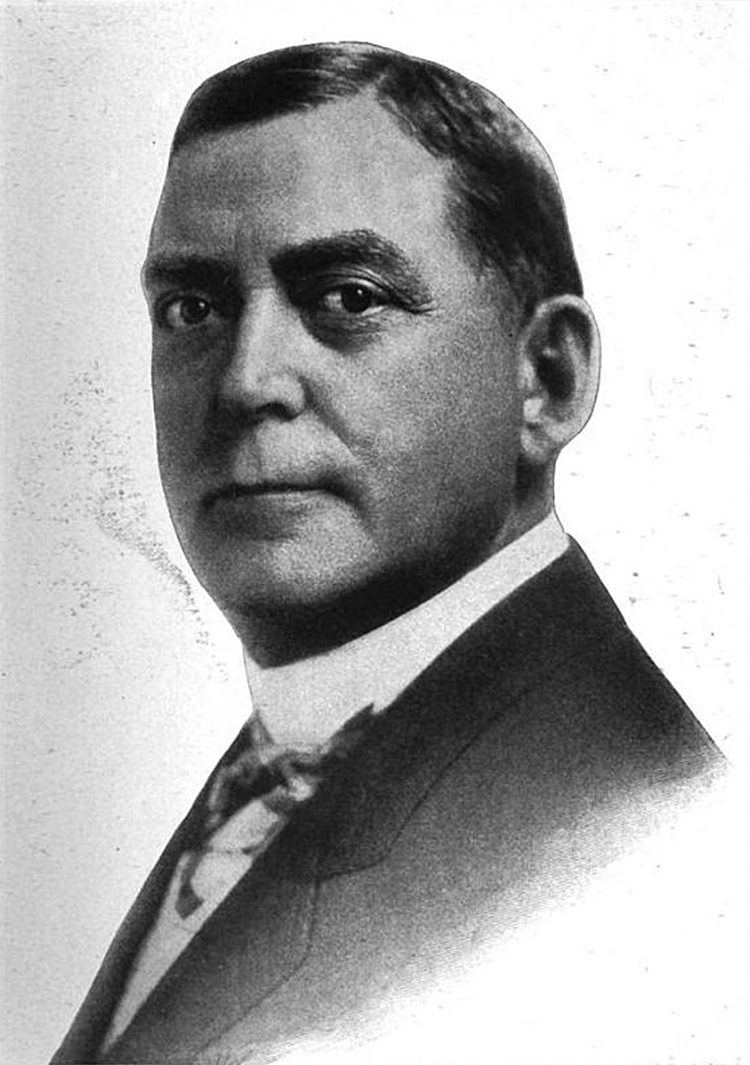
The Black Patch became an occupied country and across the state sentiment was beginning to turn against the Association. The question was posed repeatedly: why not declare victory and go home? But David Amoss was adamant that pressure must be kept up on the Duke Trust, if the hard-won progress was to endure. The Night Riders set forth once again, raiding Russellville, Kentucky, on 3 January 1908. Three hundred strong they then moved westward across the Black Patch to hit Dycusburg and the village of View, torching warehouses and mauling Trust planters at every opportunity. Then Amoss headed for Eddyville, home of the Kentucky State Penitentiary, where he and his men were able to enter the town, cut off its communications and burn its warehouses, vanishing before dawn leaving only bloodied ‘hillbillies’ in their wake. Not until 17February did Willson’s soldiers belatedly march into town.
Despite the presence of the state militia, the Night Riders were clearly capable of continuing their dirty work in small towns and villages across the region. Such enterprises often attract the worst sort of men. Brawlers, criminals, bigots joined the vigilantes for their own reasons and in the lawlessness that the Night Riders exuded they went about settling scores and taking personal vengeance. Some of these tensions went back to the Civil War, while others were familial, financial or political.
Partly due to the contamination of the Night Riders by villainous types and partly due to the issue of a cause that had run its course, by late 1908 and early 1909 Amoss began to feel the loss of a substantial percentage of his host. Meanwhile other forces of change were at work far from the Black Patch. In Washington, Representative A.O. Stanley of Kentucky’s 2nd District, a future progressivist governor who had helped draft the charter for the Dark District Tobacco Planters Association, managed to repeal the six cent per lb tax on leaf tobacco, thus lifting a great financial burden off tobacco planters nationwide. In late 1908 the New York Court of Appeals ruled that the Duke Trust was in violation of the Sherman Antitrust Act and that it must be fragmented into a number of smaller, decentralised, more democratic entities. The state militia had expanded its reach beyond the major cities of the Black Patch and began a successful programme of patrols that captured and disarmed several Night Rider bands, while court actions, when held outside the dwindling strongholds of Night Rider’ support, returned heavy verdicts and fines against captured members.
In 1910, with the militia withdrawn and night riding virtually ceased, Amoss was indicted by a Christian County grand jury for ‘willfully and feloniously confederating, conspiring and banding together for the purpose of molesting, injuring and destroying property of other persons’, with a penalty of one to five years in the penitentiary and up to $10,000 in damages. The holy oath of the Night Riders overcame fears of perjury, however, and none of the plaintiffs’ witnesses culled from former Riders would testify against their leader. The defendant’s attorney railed against the callousness of the Duke Trust and by proxy the ‘hillbillies’, whose refusal to stand united with the Association had spurred the Riders into being, while the opposing side emphasised the rule of law and the right to the safe enjoyment of one’s property and home, concluding that should Amoss go free, ‘it was time to tear down the churches and courthouses and homes’ and let socialism and anarchy run amok. The rural jury wasn’t buying it. The verdict was unanimous and Amoss walked out a free man into a Black Patch itself liberated from both the tyranny of exploitation and the terror of forced conformity.



